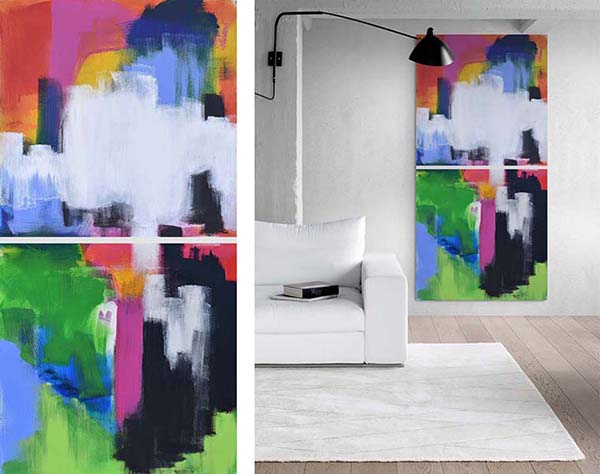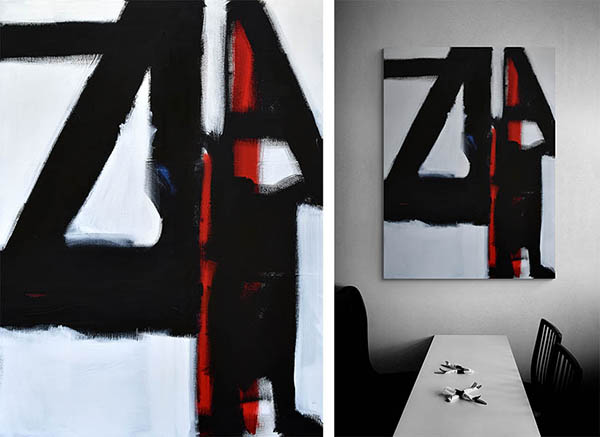
oil on canvas, 48×36″
$2400

acrylic on canvas, 36×48″
$1800

oil on canvas, 48×36″
$2000

acrylic and Sharpie on canvas, 36×36″
$800

acrylic on canvas, 60×30″
presently at ADC Fine Art, Cincinnati

acrylic on canvas, 40×30″
presently at ADC Fine Art, Cincinnati
I had no idea how much I would love art history. It had a LOT to do with my first university instructor, a tiny dynamo named Maggie. Her classes always filled rapidly. She was adept at demonstrating how artistic and architectural trends built on one another, from age to age. The course was exhausting, requiring lots of memorizing, which was easier, as Maggie suggested, if you did some of it every week rather than waiting until the day before an exam. I emerged with a triumphant ‘A’ and Maggie became a dear and supportive friend. But I digress.
I mostly want to emphasize how much whatever you’re doing depends on what came before you. You may have the most original, innovative technique since the rendering of cave paintings, but the seeds of that technique were planted somewhere. I discovered my love of color and large-scale abstraction in the work of the Post-Impressionists, Abstract Expressionists, Modernists, and Color Field Painters. I adore everything Henri Matisse ever touched. I was reduced to tears, in Paris, in the Grand Palais when I saw my all-time favorite painting, Matisse’s ‘The Piano Lesson’. Even at a young age, I was probably nine and had yet to pursue anything artistic outside of my elementary school, after my teacher talked about his cutouts, I spent several days creating Dr. Doolittle’s menagerie, in miniature, with construction paper and scissors. I mounted them on small pieces of cardboard. Goodness knows where they ended up. I was very proud of them though.
Of a different time, I’m smitten with Helen Frankenthaler and her work. I once, inadvertently, created an expressionist canvas so close to one of her paintings, I gasped when I saw an image of it in the New York Times. I was on Cloud Nine for days and gushed about to anyone who would listen. My canvas was later sacrificed to the fire gods in a fit of pique, when I couldn’t stop comparing it to hers. I have regretted it ever since. “Don’t burn your bridges,” people say. I say, “Don’t burn your paintings” (unless they really, really suck). And if they look like Frankenthaler’s, they don’t exactly suck. That was your voice coming through that work! I’m only now beginning to appreciate what that means.
As much as I appreciate that art that came before me, my attempts at outright copying have been disastrous. I’d have flunked out of any art school that required me to sit in front of classical paintings and copy them. And since I’d rather have a root canal than draw, well . . .. (Actually, the one root canal I’ve had was not that bad, so I may have to recalibrate my scale. Thanks again, Dr. Scott.)
I don’t hesitate to pull out my art history books when I’m stuck. Not only do I learn something usually, but the inspiration fairly jumps off the page. And I have my go-tos, let’s face it. If I need to, I take out my contacts. Whatever I’m looking at takes on a whole new impression with uncorrected vision. I am that near-sighted, which is what started me in abstract expressionism in the first place, but that’s a story for another time.
More than once, I’ve attended the opening of a gallery show and heard a patron standing in front of my work saying either, “I don’t get it,” or “I could do that.” I’ve also been witness to someone attempting to psychoanalyze me according to the subject matter of my painting. Yes, I want people to react to my work. And the temptation to step in and explain the work or assure the speaker that I’m a pretty stable human has not, to date, overcome the entertainment value of the scene.
Non-representational work is a mystery to a lot of people. A “tempest of form and color,” as a friend described my expressionist work, either appeals to a viewer’s aesthetic or it doesn’t. The caveat though, is that I believe the more a person learns about that kind of work, the more she will appreciate it. And maybe come to love it.
Speaking as a painter, action painting/expressionism is very freeing. I’d like to think that sensation is also experienced by a viewer. Depending on the colors used, such a painting can also be quite exciting or even serene. I’m extremely fond of black and white and all the shades of gray between. And the slightest touch of red will make it sing.
I’m not going to say non-representational work is easy. Creating a piece that’s balanced, cohesive and pleasing is challenging. But it is so much fun. The energy of the artist comes shining through. I think that’s what a lot of viewers relate to. And if they don’t, maybe they’re not trying.
Most people might argue they shouldn’t have to work to understand a piece, that it should speak to them without any effort on their part. And there are works like that, of course. I’m a huge fan of hard-edge minimalism, for heaven’s sake. My work in that genre creates a definite impact. A deep dive into meaning or technique doesn’t reveal much more. But that’s certainly not true of all non-representational work. Most of it is very layered – colors are carefully chosen and applied. Forms are allowed to recede or pop. An awareness of the artists’ technique will go a long way in developing an appreciation of the genre.